It feels really good to be loading shotshells again. I’ve been so busy with metallic reloading and shooting recently that I haven’t made shotgunning a priority. A recent trip with my brother-in-law skeet shooting has motivated me to get the shotguns out more frequently. I’ve also used up much of my 20 gauge shells taking care of rattlesnakes around the Ultimate Reloader Outpost. And what about quail and grouse hunting? Clearly I need to “get back into the game” loading both 20 gauge and 12 gauge shells! In this post, we’ll take a look at reloading 20 gauge shells with the MEC 600 JR Mark V single-stage press. As you’ll see- it’s a great tool for this job!
Components and Load Data
For these loads, I used the following:
- Cheddite 20 gauge 2 3/4″ pre-primed hulls from Ballistic Products (also reloaded these after firing)
- Fiocchi 616 209-style shotshell primers
- Federal 20S1 wad columns
- Lawrence #8 lead shot
- Hodgdon Universal powder
Load data (from Hodgdon.com) using components above:
- Shot charge: 7/8 oz
- Powder Charge (Hodgdon Universal): 17.0 grains (starting) – 18.1 grains (max)
Use load data at your own risk. Ultimate Reloader is not responsible for errors in load data on this website. Always cross-reference load data with manufacturer’s published data.
There are a few things to think about when you select load data, and the thought process is a tad different than metallic reloading data selection. The shot you select will change your pattern and should be optimized based on the game you’re planning to hunt, or targets you want to shoot. The hulls you’ll load will have either tapered walls or straight walls- this will influence which wad you’ll select. The wad column (sometimes referred to simply as the “wad”) will have dimensions that will affect shot capacity and overall load volume. The powder should be chosen based on the gauge you’re loading, and the load data will call out which hull and wad will work well with it.
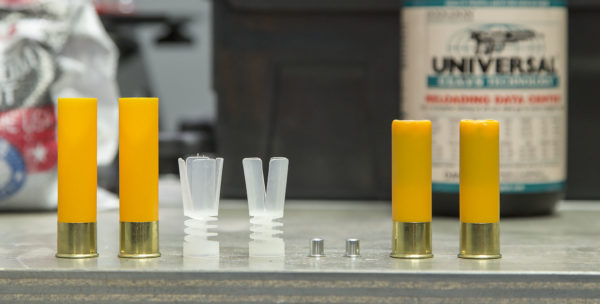
From left: Cheddite 20 gauge pre-primed hulls (new), Federal 20S1 wad columns, Fiocchi 616 209-sized primers, loaded shells. Background: shot (left), Hodgdon Universal powder (right). Let’s take a look at how these components come together using the MEC 600 JR Mark V!
MEC 600 JR Mark V Setup and Stations
The MEC 600 JR Mark V comes “ready to roll” with just a couple things you need to think about or take care of:
- Removing the powder charge plug, replacement with powder bushing (see last MEC 600 JR Mark V post for details), validating powder charge
- Validating shot charge
- Selecting proper crimp starter (6 pleat or 8 pleat) and swapping if needed
Once you’ve completed these steps and selected your components and load data, it’s time to run a test shell through the press. This is where the MEC 600 JR Mark V really shines- it’s really simple to run a single shell through the stations since it’s a single-stage. Here’s the station layout on the MEC 600 JR Mark V:
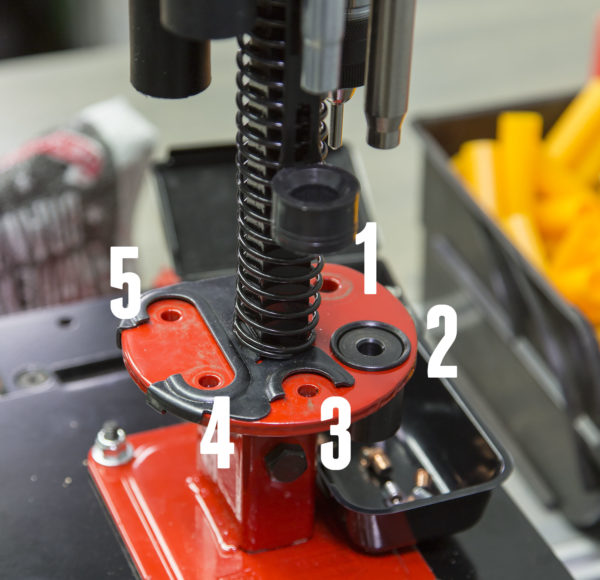
These stations are as follows:
- Sizing and de-priming
- Priming
- Powder charging, wad insertion, shot charging
- Crimp starter
- Crimp finisher
I ended up swapping out the 8-pleat crimp starter for the 6-pleat crimp starter: they pop off and pop back on when you push up on them, a handy design. I found the included bushings (#20, #22, #24) to span the range of powder charge data nicely. Once you get setup, the 600 JR Mark V works very well and smoothly. It’s not an expensive setup, but you can really see and feel the quality construction and great engineering when you get into the rhythm of loading shells with this press. This is a great press to get started with because it’s very simple to use and setup. Many experienced reloaders that load in bulk will want to upgrade to a progressive shotshell reloader (completes a shell with each stroke) because of the efficiency of such a press. But you’ll still want a press like the MEC 600 JR Mark V even if you have a progressive shotshell loader because a single stage is the ideal type of press to work up loads with- very simple to crank out a single shell, and easy to tweak the settings station-by-station. If you aren’t in a hurry, this press will do everything you’ll need it to! Another thing about the MEC 600 JR Mark V: it’s 100% made in the USA, and that’s worth a LOT in my book!
Notes and Learnings
My shells have functioned 100% in my Mossberg Model 500 20 gauge shotgun. However, the Cheddite hulls have a larger capacity than what I had planned on, so the pleats were tilted in slightly (concaved). With only Federal 20S1 wad columns on-hand, I dissected a factory Winchester 20 gauge shell which uses a taller wad column and loaded it with with a new Cheddite hull. I found the taller wad column to solve the volume issue- the pleats coming together more-or-less level (not poking out and not caved-in). So for bulk loading of these Cheddite hulls, I’ll look for a taller wad column. For the Federal 20S1 wad columns, I’ll look to use hulls with lower capacity (such as Federal hulls)- I believe they will load perfectly, but I’ll need to experiment to find out for sure.
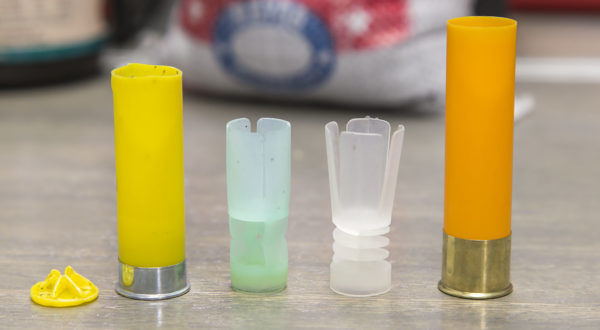
Above we have from left: Winchester Super-X 20 Gauge 2 3/4″ 7/8oz. #8 Shot hull (top removed), wad column from Winchester Super-X shell, Federal 20S1 wad column, Cheddite 20 gauge pre-primed new hull. And here you can see the difference the taller hull from the Super-X shell made:
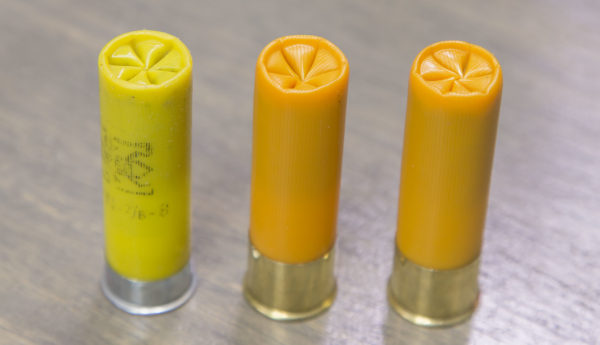
Above we have at left: a factory Winchester Super-X 20 Gauge 2 3/4″ shell with 7/8oz. #8 Shot. Center: loaded shell with Federal 20S1 wad column (load data listed earlier in this article). Right: A loaded shell swapping out only the wad column (from the Winchester Super-X shell taken apart). The volume looks good, and I think with some small adjustments, this setup would be perfected. I’ll save those fine tuning steps for when I get different wad columns or hulls.
In the end I really have fun using the MEC 600 JR Mark V- and that’s what it’s all about, right? Reloading is about getting exactly what you want, saving money, and having fun. That’s why I enjoy this pastime so much! Stay tuned for more MEC content coming up! Do you have a MEC 600 JR Mark V? Please drop a comment and share your experiences!
Thanks,
Gavin
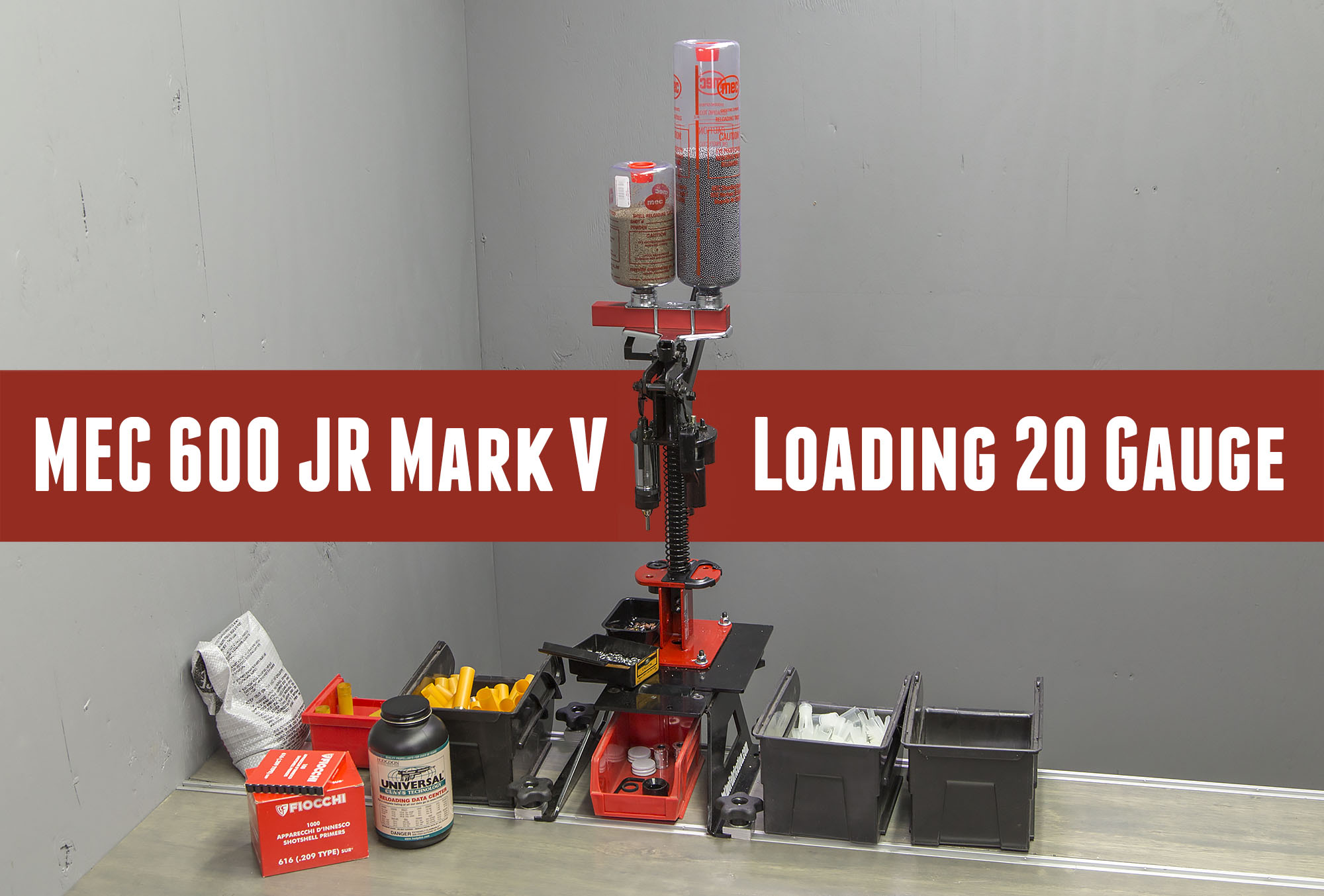


















































































Hey Gavin I have three Mec presses, I also have an RCBS Grand fully Progressive you can really have some fun with that press. Love your videos!
Gavin,
I have been reloading on MEC Grabber’s for over 33 years for my Skeet loads in 12, 20, 28 and .410. Just a few pointers. I pour my shot into a smaller, solid container, then pour it thru a funnel into the shot hopper. The shot is heavy and will shift when pouring it right out of the bag, and it is no fun picking it up. Another thing to do is “prime your powder” by running about ten charges before you start loading. You also must weigh your shot charge to confirm it is correct. The bushing charts are not accurate. They only get you close. Depending on your bench, your handling of the press, etc, the charge can be off by one or two bushings either smaller or larger. You can also fine tune your powder drop by using a rat tail file to ream the bushing in order to get it exactly as specified.
I am having an issue with dropping to much shot I wish to reload a Winchester AA super sport 7/8 oz,my wad is AA Winchester in 20 gauge loader is set to push wad @ 7/8 but still seems to overfll now my shot is # 8 but I wouldn’t think that would matter please help if you can . Thank you.
Call me to make sure of proper setting on the loader I had same problem found my wad pusher was set wrong